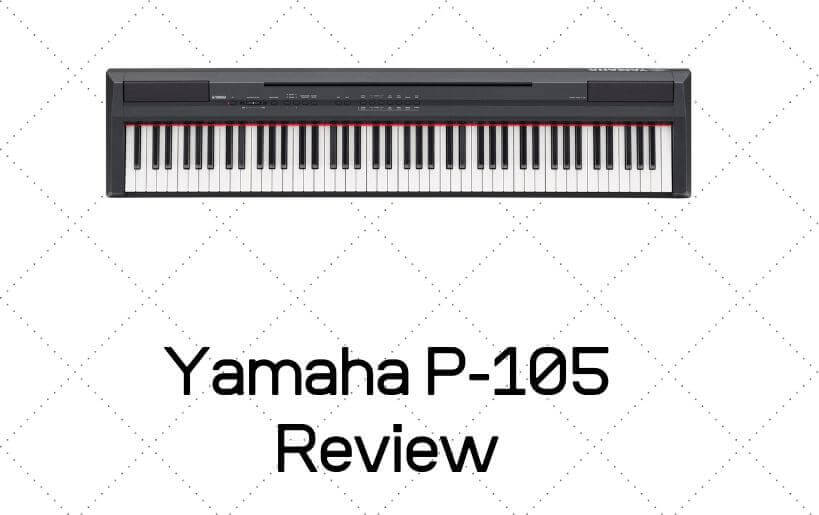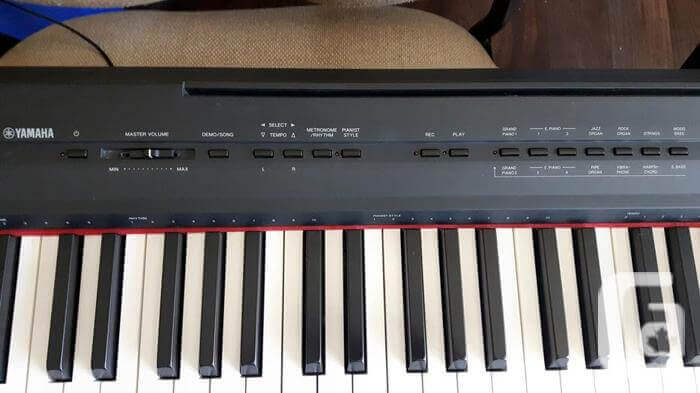
Have you outgrown your beginner keyboard piano and are now looking forward to one that will stimulate a real piano? Then, you’re lucky to be here as we have brought the right piano for your skill level and that is the Yamaha P105. We admit that this is not a perfect piano and since we do not lie to get our affiliate products sold, we will be informing you about the things we didn’t like about this keyboard.
Our goal is to put forward our expert opinion and an honest review of all the products that we promote. So, read thoroughly our Yamaha P105 review and see if this keyboard is the right one for you.
Quick Navigation
Features Of Yamaha P105:
We found the Yamaha P105 to be a great keyboard for not only beginners but also for intermediate and even professional players. Keep in mind, this keyboard is the successor of Yamaha 95 and it has been built to replicate Yamaha’s very own CFIII concert grand acoustic piano. Although it costs less than $600 it has a lot to offer.
Aesthetics

Aesthetics is usually not as important as sound and key sensitivity when it comes to qualifying a keyboard, but we know how everyone wants to get their hands on a keyboard that is elegant, compact, and portable. Therefore, we’ll start from the aesthetics of the Yamaha P105.
The P105 weighs 36 lbs which is more than most of the digital pianos that we review. This can make it hard to carry between your classroom, your gigs, and your home. However, being 52-inch-long and 11-inch-wide, this is quite compact, and you’ll find many surfaces where you can place it.
The P105 is only available in matte black but it looks so elegant in this color that no other color will suit it as much.
However, it’s not a wise thing to play a digital piano on a surface where you’re uncomfortable playing. You might want to get a piano stand for this purpose, and you can get the L-85 stand which is specially made for the P105. You’ll also get the 3-unit pedal with the L-85 stand in a package. Both of these will be an added cost but since you’ll need a pedal and a stand, we would strongly advise you to get these rather than another stand that will not sit well with the P105.
Sound quality and memory
The P105 is equipped with Yamaha’s proprietary CF sound engine which is one of the most acclaimed sound engines in the world of digital pianos. You’ll hear and feel every note played on this piano clearly and distinctly.
While the CF sound engine ensures higher sound quality, it does not guarantee the number of built-in sounds which in case the Yamaha P105 is 14. Although this is not bad there are keyboards with more built-in sounds. However, like we’ve said the quality of sound matters more than quantity and with 14 sounds you can still do a lot more.
Another thing to like about the sound memory of the Yamaha P105 is that it allows polyphony of up to 128 notes. Moreover, it has 10 built-in rhythms and 10 built-in styles. These are great added features for anyone who likes to experiment with a different combination of notes, rhythm, and style. Also, it’s a valuable asset to have in a digital piano.
Key sensitivity

When It comes to the key sensitivity of the Yamaha P105, it is good to know that it has graded hammer action keys by using tiny hammers. It means that the keys of the lower notes will provide more resistance while the keys with higher notes will provide less resistance. This is very important to have in a digital piano if you’re serious about your playing skills and want to move up the ladder someday.
Furthermore, you can adjust the sensitivity to four levels; soft, medium, harder, and fixed.
However, professionals or anyone who has used top-notch digital pianos or acoustic pianos will immediately feel the difference. It’s not to say that the quality is bad, but it is not that great either. Beginners and even intermediate players can find solace in the P105, but experts would want to move on to keyboards with better key sensitivity.
Still, what can you expect from a digital piano of this price range? You can only expect as much as you’re paying for.
Other features
Since the Yamaha P105 has done well on the main features, we can now look at the other features that are although not essential, but they can make your life easier.
One of these features is connectivity and we are glad to find the P105 having a USB port and an auxiliary line out. While the USB port can allow you to sync the P105 with the different music composition applications, the auxiliary cable will allow you to plug in into amplifiers. Connecting with amplifiers through auxiliary cable can be most relieving for live performances.
When it comes to the speaker of the P105, we are a bit disappointed. The P105 has two small-sized speakers which are not enough for even a medium-sized room let alone a concert hall. To overcome this weakness, you can plug in external speakers through amplifiers but still one likes to have good-sized speakers built-in.
Moreover, you can plug in headphones and practice in silence if you want to listen to the nuances of the music that you are making without disturbing anyone else.
You also have the added features of split, layering, and duo. An internal recorder is also present in the P105, but it can only record up to one song.
Yamaha P105 Overview:
Pros & Cons Of Yamaha P105:
Now that we have discussed every aspect and feature in detail, its time we break them down into simple pros and cons. This will allow you to weigh them and see if the P105 is worth your money.
Pros:
- Affordable
- Compact and decent looking
- Good sound quality
- Weighted and graded key action
- Adjustable key sensitivity
- 128 note polyphony
- 14 built-in voices, 10 built-in rhythms, and 10 built-in styles
Cons
- Comparatively heavier
- Small speakers
- Lacking premium key sensitivity
Conclusion
As you can judge by looking at the pros and cons, the P105 is more of a winner and the flaws it has can either be overcome or compromised with given the price of the instrument. For beginners, this is a great piano and by getting this they won’t have to buy another for many years to come. Only when you have surpassed the intermediate skill level phase, then you’ll need to get a better digital piano.
Let us know what you think and what queries you have.